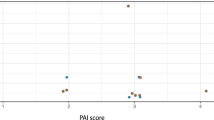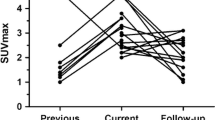Abstract
Objectives
Clinical features and imaging findings of maxillo-mandibular actinomycosis are similar to those of intraosseous carcinoma. The purpose of this study is to clarify the characteristics of the imaging findings for screening of maxillo-mandibular actinomycosis using CT and PET.
Methods
Reports on maxillo-mandibular actinomycosis published between 1997 and 2016 were searched in PubMed using “actinomycosis,” “maxilla,” and “mandibular” as keywords. Ten cases suspected to have malignant tumors on diagnostic imaging findings were selected. In addition, three patients who visited Gunma University Hospital were also included. The 13 total cases were subjected to a pooled analysis of diagnostic screening of maxillo-mandibular actinomycosis using CT, 18F-FDG-PET/CT (FDG-PET/CT) and 18F-α-methyl tyrosine PET/CT (FAMT-PET/CT). Additionally, cases of intraosseous carcinoma were analyzed as comparative controls to investigate the difference between maxillo-mandibular actinomycosis and intraosseous carcinoma on CT imaging.
Results
CT images of the 13 cases with maxillo-mandibular actinomycosis were investigated; spotty-type bone resorption was observed in 66.7% (8/12). Moreover, FDG-PET/CT showed abnormal accumulation, but FAMT-PET/CT showed no apparent abnormal accumulation.
Conclusions
Clinical and imaging findings of maxillo-mandibular actinomycosis are similar to those of intraosseous carcinoma. Differential diagnostic screening can confirm spotty-type bone resorption in cortical bone with CT and specific accumulation in malignant tumors with FAMT-PET/CT. This screening facilitates the rapid implementation of therapeutic interventions.




Similar content being viewed by others
References
Bochev V, Angelova I, Tsankov N. Cervicofacial actinomycosis-report of two cases. Acta Dermatoven APA. 2003;12:105–8.
Vorasubin N, Wu AW, Day C, Suh JD. Invasive sinonasal actionomycosis: case report and literature review. Laryngoscope. 2013;123:334–8. https://doi.org/10.1002/lary.23477.
Schaal KP, Beaman BL. Clinical significance of actinomycosis. In: Goodfellow A, Mordarski M, William ST, editors. The biology of actinomycetes. London: Academic Press; 1984. p. 389–424.
Shindo J. The situation of oral actinomycosis : analysis of 140 cases in 45 facilities. Jpn J Oral Maxillofac Surg. 1983;29:1879–89.
Sa’do B, Yoshiura K, Yuasa K, Ariji Y, Kanda S, Oka M, et al. Multimodality imaging of cervicofacial actinomycosis. Oral Surg Oral Med Oral Pathol. 1993;76:772–82.
Nagler R, Peled M, Laufer D. Cervicofacial actionomycosis. Oral Surg Oral Med Oral Pathol Oral Radiol Endod. 1988;85:496–508.
Miller HS, Paul WH, Duane WN, Bill L, Sean PE, David MA. Mandibular Actinomyces osteomyelitis complicating florid cemento-osseous dysplasia. BMC Oral Health. 2011. https://doi.org/10.1186/1472-6831-11-21.
Park JK, Lee HK, Ha HK, Choi HY, Choi CG. Cervicofacial actinomycosis: CT and MR imaging findings in seven patients. AJNR Am J Neuroradiol. 2003;24:331–5.
Kaira K, Endo M, Abe M, Nakagawa K, Ohde Y, Okumura T, et al. Biologic correlation of 2.-(18F)-fluoro-2-deoxy-d-glucose uptake on positron emission tomography in thymic epithelial tunors. J Clin Oncol. 2010;28:3746–53.
Kaira K, Serizawa M, Koh Y, Takahashi T, Hanaoka H, Oriuchi N, et al. Relationship between 18F-FDG uptake on positron emission tomography and molecular biology in malignant pleural mesothelioma. Eur J Cancer. 2012;48:1244–54.
Nakasone Y, Inoue T, Oriuchi N, Takeuchi K, Negishi A, Endo K, et al. The role of whole-body FDG-PET in preoperative assessment of tumor staging in oral cancers. Ann Nucl Med. 2001;15:505–12.
Miyakubo M, Oriuchi N, Tsushima Y, Higuchi T, Koyama K, Arai K, et al. Diagnosis of maxillofacial tumor with L-type (18F)fluoro-a-methyl tyrosine (FAMT) PET: a comparative study with FDG-PET. Ann Nucl Med. 2007;21:129–35.
Senft A, de Bree R, Hoekstra OS, Kuik DJ, Golding RP, Oyen WJ, et al. Screening for distant metastasis in head and neck cancer patients by chest CT or whole body FDG-PET: a prospective multicenter trial. Radiother Oncol. 2008;87:221–9.
Oriuchi N, Higuchi T, Ishikita T, Miyakubo M, Hanaoka H, Iida Y, et al. Present role and future prospect of positron emission tomography in clinical oncology. Cancer Sci. 2006;97:1291–7.
Xie P, Li M, Zhao H, Sun X, Fu Z, Yu Z. 18F-FDG PET or PET-CT to evaluate prognosis for head and neck cancer: a meta-analysis. J Cancer Res Clin Oncol. 2011;137:1085–93.
van den Hoff J, Oehme L, Schramm G, Maus J, Lougovski A, Petr J, et al. The PET-derived tumor-to-blood standard uptake ratio (SUR) is superior to tumor SUV as a surrogate parameter of the metabolic rate of FDG. EJNMMI. 2013;3:77. https://doi.org/10.1186/2191-219X-3-77.
Kim M, Higuchi T, Arisaka Y, Achmad A, Tokue A, Tominaga H, et al. Clinical significance of 18F-a-methyl tyrosine PET/CT for the detection of bone marrow invasion in patients with oral squamous cell carcinoma: comparison with 18F-FDG PET/CT and MRI. Ann Nucl Med. 2013;27:423–30.
Kim M, Achmad A, Higuchi T, Arisaka Y, Yokoo H, Yokoo S, et al. Effects of intratumoral inflammatory process on 18F-FDG uptake: pathologic and comparative study with 18F-a-methyl tyrosine PET/CT in oral squamous cell carcinoma. J Nucl Med. 2015;56:16–211.
Nobusawa A, Kim M, Kaira K, Miyashita G, Negishi A, Oriuchi N, et al. Diagnostic of 18F-FAMT PET and L-type amino acid transporter 1(LAT1) expression in oral squamous cell carcinoma. Eur J Nucl Med Mol Imaging. 2013;40:1692–700.
Wiriyasermkul P, Nagamori S, Tomoinaga H, Oriuchi N, Kaira K, Nakao H, et al. Transport of 3-fluoro-L-a-methyl-tyrosine by tumor-upregulated L-type amino acid transporter 1: a cause of the tumor uptake in PET. J Nucl Med. 2012;53:1253–61.
Hariya Y, Yuasa K, Nakayama E, Kawazu T, Okamura K, Kanda S. Value of computed tomography findings in differentiating between intraosseous malignant tumors and osteomyelitis of the mandible affecting the masticator space. Oral Surg Oral Med Oral Pathol Oral Radiol Endod. 2003;95:503–9.
Finley AM, Beeson MS. Actinomycosis osteomyelitis of the mandible. Am J Emerg Med. 2010;28(118):e1–4. https://doi.org/10.1016/j.ajem.2009.04.026.
Gannepalli A, Ayinampudi BK, Baghirath PV, Reddy GV. Actinomycotic osteomyelitis of maxilla presenting as oroantral fistula: a rare case report. Case Rep Dent. 2015. https://doi.org/10.1155/2015/689240.
Chatterjee RP, Shah N, Kundu S, Mahmud SA, Bhandari S. Cervicofacial actinomycosis mimicking osseous neoplasm: a rare case. J Clin Diagn Res. 2015;9:29–31.
Vázquez E, López-Arcas JM, Navarro I, Pingarrón L, Cebrián JL. Maxillomandibular osteomyelitis in osteopetrosis. Report of case and review of the literature. Oral Maxillofac Surg. 2009;13:105–8.
Kim NR, Park JB, Ko Y. Differential diagnosis and treatment of periodontitis-mimicking actinomycosis. J Periodontal Implant Sci. 2012;42:256–60.
Smith MH, Harms PW, Newton DW, Lebar B, Edwards SP, Aronoff DM. Mandibular Actinomyces osteomyelitis complicating florid cemento-osseous dysplasia. BMC Oral Health. 2011. https://doi.org/10.1186/1472-6831-11-21.
Figueiredo LM, Trindade SC, Sarmento VA, de Oliveira TF, Muniz WR, Valente RO. Actinomycotic osteomyelitis of the mandible: an unusual case. Oral Maxillofac Surg. 2013;17:299–302.
Sasaki Y, Kaneda T, Uyeda JW, Okada H, Sekiya K, Suemitsu M, et al. Actinomycosis in the mandible: CT and MR findings. AJNR Am J Neuroradiol. 2014;35:390–4.
Sezer B, Akdeniz BG, Günbay S, Hilmioğlu-Polat S, Başdemir G. Actinomycosis osteomyelitis of the jaws: report of four cases and a review of the literature. J Dent Sci. 2013;12:301–7.
Ida M, Tetsumura A, Kurabayashi T, Sasaki T. Periosteal new bone formation in the jaw. a computed tomographic study. Dentomaxillofac Radiol. 1997;26:169–76.
Pulverer G, Schuütt-Gerowitt H, Schaal KP. Human cervicofacial actionmycoses: microbiological data for 1997 cases. Clin Infect Dis. 2003;37:490–7.
Kondou T, Ohta Y, Matsumoto Y, Matsuura M, Seto K, Shindou J. Central actinomycosis of the mandible: Report of a case. Jpn J Oral Maxillofac Surg. 1983;29:1326–31.
Saitou H. Actinomyces nocardiosis. Toda new bacteriology. Nanzando. 1989;29:478–82.
Kimura Y, Araki K, Hanasawa T, Sakamaki K, Okano T. CT and US appearances of osteomyelitis of the mandible with actinomycosis. Jpn J Dent Rad. 2001;41:231–9.
Nakagawa Y, Asada K, Doi Y, Ochiai M, Maruyama T, Ishibashi K. Oral and maxillofacial actinomycosis. Clinical and bacteriogical studies of 13 cases. Jpn J Oral Maxillofac Surg. 1985;31:110–5.
Funding
This research received no specific grant from any funding agency in the public, commercial, or not-for-profit sectors.
Author information
Authors and Affiliations
Corresponding author
Ethics declarations
Conflict of interest
Author Keisuke Suzuki, Author Jun Kurihara, Author Mai Kim, Author Sakura Yanagisawa, Author Masaru Ogawa, Author Takaya Makiguchi, and Author Satoshi Yokoo declare that they have no conflict of interest.
Human and animal rights statement
All procedures followed were in accordance with the ethical standards of the responsible committee on human experimentation (institutional and national) and with the Helsinki Declaration of 1964 and later versions.
Informed consent
Informed consent was obtained from all patients for being included in the study.
Additional information
Publisher's Note
Springer Nature remains neutral with regard to jurisdictional claims in published maps and institutional affiliations.
Rights and permissions
About this article
Cite this article
Suzuki, K., Kurihara, J., Kim, M. et al. Image screening for maxillo-mandibular actinomycosis with CT, 18F-FDG-PET/CT, and 18F-α-methyl tyrosine PET/CT. Oral Radiol 37, 46–54 (2021). https://doi.org/10.1007/s11282-020-00421-6
Received:
Accepted:
Published:
Issue Date:
DOI: https://doi.org/10.1007/s11282-020-00421-6




